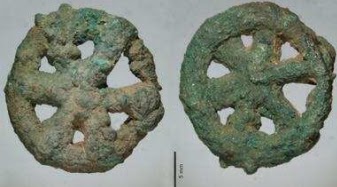--Goldsmith, lapidary signified by a oung bull with spoked wheel kunda 'lathe', kundār, 'turner, lapidary, goldsmith'
This monograph provides 1) archaeological evidence for a potter's wheel which is the model for the cire perdue copper alloy artifacts of Mehrgarh; and 2) decipherment of Indus Script Sign 291 'spoked wheel' as āre'potter's wheel' rebus: āra 'brass'.Thus, the Indus Script Corpora contains documentation of wealth-accounting ledgers and metalwork on metals such as brass. The combined expression signified a young bull PLUS spoked wheel sign is kunda, 'lathe' PLUS ār, 'persons, artificers' = hypertext 'kundār,'turners, lapidarie, goldsmiths' (guild)..
This is an addendum to
āre potter's wheel (Gondi) ārū आ॑रू॒ 'circle' (Kashmiri) ār̤i 'circle' (Tamil.Kannada) rebus āra 'brass' https://tinyurl.com/yxbc7d33
I suggest that the one-horned youngbull PLUS spoked wheel on neck (ligature) is an orthoggraphic style to signify an expression consisting of two words (logos):
I suggest that the one-horned youngbull PLUS spoked wheel on neck (ligature) is an orthoggraphic style to signify an expression consisting of two words (logos):
कोंद kōnda 'young bull' PLUS āre potter's wheel (Gondi) yield the combined expression kundār 'turner, lapidary who works with the lathe'..He also works with fine gold: Ta. kuntaṉam interspace for setting gems in a jewel; fine gold (< Te.). Ka. kundaṇa setting a precious stone in fine gold; fine gold; kundana fine gold. Tu. kundaṇa pure gold. Te. kundanamu fine gold used in very thin foils in setting precious stones; setting precious stones with fine gold. (DEDR 1725). This artisan's professional competence is semantically reinforced by a part of the standard device normally shown in front of the young bull; this part is kunda 'lathe'.
Kannada has a word which explains ār, āru 'a frame put on the neck of cattle'; This is the lexeme which explains why a spoked wheel is ligatured on the neck of the young bull; the scribe intends to convey the underlying word ār, āru. This is read rebus: 1) as a suffix to indicate the perfomer artisan on a lathe: and 2) as spokes of potter's wheel āru which is signified by the orthography of th sign āru 'circle' which is read rebus as āra 'brass'; thus, a lapidary working with a lathe and brass metal.
![]() Sign 391 The -āra- ān suffix signifies a performer, a person. Thus, kundār is a lathe turner, lapidary who works with the lathe, say, to pierce stone beads and create perforated beads. Ind old Tamil, the suffix -ar signifies plurality:
Sign 391 The -āra- ān suffix signifies a performer, a person. Thus, kundār is a lathe turner, lapidary who works with the lathe, say, to pierce stone beads and create perforated beads. Ind old Tamil, the suffix -ar signifies plurality: அர் ar , part. 1. Pers. pl. suff.; பலர்பால் விகுதி. அரசர் வந்தனர் . 2. Honorific pl. suff.; உயர்வுப்பன்மை விகுதி. சம்பந்தர் பாடினர் . 3. An expletive affixed to some words; பகுதிப்பொருள் விகுதி. முன்னர் (குறள் , 435).
The suffix -ār also signifies plurality: ஆர்3 ār , part. 1. Term. of the 3rd pers. pl. of the rational class, as in வந்தார்; பலர்பாற்படர்க்கை விகுதி . 2. The 3rd pers. honorific pl. suff., as in தகப்பனார்; மரியாதைப் பன்மைவிகுதி . 3. An expletive; ஓர் அசை .
The standard device in front of the young bull includes a lathe as the top register. The word is: kunda 'lathe' kunda1 m. ʻ a turner's lathe ʼ lex. [Cf. *cunda -- 1] N. kũdnu ʻ to shape smoothly, smoothe, carve, hew ʼ, kũduwā
ʻsmoothly shapedʼ; A. kund ʻ lathe ʼ, kundiba ʻ to turn and smooth in a lathe ʼ, kundowā ʻsmoothed and rounded ʼ; B. kũd ʻ lathe ʼ, kũdā,
kõdā ʻ to turn in a lathe ʼ; Or. kū˘nda ʻ latheʼ, kũdibā,kū̃d° ʻ to turn ʼ (→ Drav. Kur. kū̃d ʻ lathe ʼ); Bi.kund ʻ brassfounder's lathe ʼ; H. kunnā ʻ to shape on a lathe ʼ, kuniyā m. ʻ turner ʼ, kunwā m. (CDIAL 3295). kundakara m. ʻ turner ʼ W. [Cf. *cundakāra -- : kunda -- 1, kará -- 1] A. kundār, B. kũdār, °ri, Or. kundāru; H. kũderā m. ʻ one who works a lathe, one who scrapes ʼ, °rī f., kũdernā ʻ to scrape, plane, round on a lathe ʼ(CDIAL 3297).
